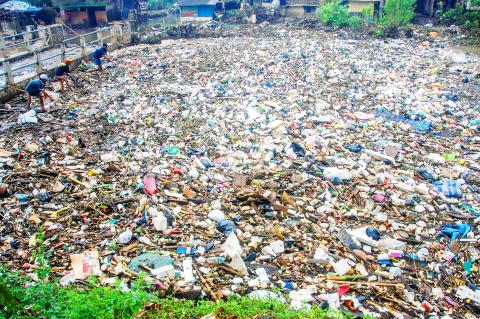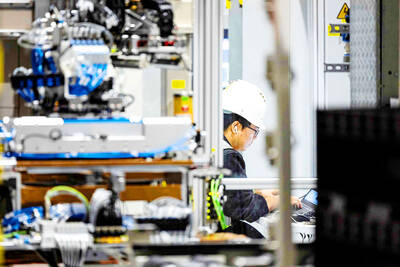The scabies on Indonesian rice farmer Yusuf Supriyadi’s limbs are a daily reminder of the costs of living next to the “world’s dirtiest river.”
Supriyadi depends on the Citarum River’s murky waters — a floating carpet of household garbage, toxic chemicals and animal feces — to irrigate a small rice plot in West Java Province that sustains his family of six.
The farmer’s rice yield is now down by two-thirds in the rainy season as textile factories dump increasing amounts of industrial waste into the river, but he has few other options.

Photo: AFP
“There are floods during the rainy season. My hands get itchy and the harvest is damaged,” the 54-year-old told Agence France-Presse. “Pollution makes my rice hollow. If I keep going I’ll lose money, but if I don’t, I’ll have no other job.”
Now faced with a health emergency after decades of failed cleanup efforts, Jakarta is stepping in with a seemingly impossible goal: make the Citarum’s water drinkable by 2025.
Using this polluted water is a risky calculation for many of the 30 million people who rely on it for irrigation, washing and even drinking water — including about 80 percent of residents in the sprawling capital, Jakarta.
At nearly 300km long, the river is also a key source for hydroelectric power for Indonesia’s most populated island, Java, and tourism hot spot Bali.
The World Bank declared it the most polluted river in the world a decade ago, a description widely picked up by media and environmentalists.
Waste levels can vary depending on how pollution is measured and the time of the year, but the Citarum is dangerous by almost any standard.
Previous research has shown it has alarming levels of toxic chemicals — including 1,000 times more lead than the US standard for safe drinking water.
It regularly appears on most polluted lists alongside India’s Ganges River, the US’ Mississippi River and China’s Yellow River.
In January, Jakarta yanked responsibility away from local governments and vowed to get tough on business owners who ignore waste disposal rules. Factories that fall short could have operating permits revoked.
CCTV cameras are to be installed along the river’s banks to keep an eye out for offenders dumping waste in the early morning hours to evade detection.
Meanwhile, dredging equipment is to be used to clean up the filthy river, Indonesian Ministry of Maritime Affairs and Fisheries spokesman Djoko Hartoyo said.
“We are not playing around this time,” he said. “We’re going in with a holistic approach, so we are optimistic we can make Citarum clean again, just like it was 50 or 60 years ago.”
In the 1980s, a new industrial zone sprang up around the small town of Majalaya, about 170km east of Jakarta, and things quickly changed for the pristine river.
About 2,000 textile factories in the area have provided much-needed jobs, but they came with a heavy cost: About 280 tonnes of industrial waste are dumped into the river each day, government and environmental group data showed.
Making matters worse, many locals think nothing of tossing their household waste into its toxic waters.
“When it rains and my house gets flooded, the smell is awful,” Achmad Fachrureza said from inside an inflatable dingy as he navigated the river’s polystyrene foam containers, fabric, empty cans, plastic bottles and garbage bags.
The 57-year-old villager said he was fired from his job as a textile factory security guard after asking questions about the firm’s waste disposal system.
Factory pipes dump waste directly into waters bubbling with chemical dyes used in textiles, creating an overwhelming stench.
“Most factories here have a waste disposal system, but they don’t work properly, because it’s just a formality,” said Deni Riswandani of Elingan, a local environmental group.
That poses a serious health risk, especially for the 5 million people living in the river’s basin. Many locals suffer from skin diseases such as scabies and dermatitis, as well as respiratory infections from inhaling factory pollution.
“The number of people going to the health clinic is very high,” Riswandani said. “We keep reporting these issues to the government, but we never get a solution.”
He and other frustrated activists have blocked some waste pipes with rocks and concrete, but the factories usually remove the blockage right away.
Locals hope Jakarta’s new goals can be achieved, but they are also skeptical given the scale of the task and endemic corruption that could see factory owners try to buy their way out of trouble.
“I long to see the Citarum like it was when I was young,” Fachrureza said. “I could swim in it and drink the water. It was so clean.”

CHIP RACE: Three years of overbroad export controls drove foreign competitors to pursue their own AI chips, and ‘cost US taxpayers billions of dollars,’ Nvidia said China has figured out the US strategy for allowing it to buy Nvidia Corp’s H200s and is rejecting the artificial intelligence (AI) chip in favor of domestically developed semiconductors, White House AI adviser David Sacks said, citing news reports. US President Donald Trump on Monday said that he would allow shipments of Nvidia’s H200 chips to China, part of an administration effort backed by Sacks to challenge Chinese tech champions such as Huawei Technologies Co (華為) by bringing US competition to their home market. On Friday, Sacks signaled that he was uncertain about whether that approach would work. “They’re rejecting our chips,” Sacks

It is challenging to build infrastructure in much of Europe. Constrained budgets and polarized politics tend to undermine long-term projects, forcing officials to react to emergencies rather than plan for the future. Not in Austria. Today, the country is to officially open its Koralmbahn tunnel, the 5.9 billion euro (US$6.9 billion) centerpiece of a groundbreaking new railway that will eventually run from Poland’s Baltic coast to the Adriatic Sea, transforming travel within Austria and positioning the Alpine nation at the forefront of logistics in Europe. “It is Austria’s biggest socio-economic experiment in over a century,” said Eric Kirschner, an economist at Graz-based Joanneum

BUBBLE? Only a handful of companies are seeing rapid revenue growth and higher valuations, and it is not enough to call the AI trend a transformation, an analyst said Artificial intelligence (AI) is entering a more challenging phase next year as companies move beyond experimentation and begin demanding clear financial returns from a technology that has delivered big gains to only a small group of early adopters, PricewaterhouseCoopers (PwC) Taiwan said yesterday. Most organizations have been able to justify AI investments through cost recovery or modest efficiency gains, but few have achieved meaningful revenue growth or long-term competitive advantage, the consultancy said in its 2026 AI Business Predictions report. This growing performance gap is forcing executives to reconsider how AI is deployed across their organizations, it said. “Many companies

France is developing domestic production of electric vehicle (EV) batteries with an eye on industrial independence, but Asian experts are proving key in launching operations. In the Verkor factory outside the northern city of Dunkirk, which was inaugurated on Thursday, foreign specialists, notably from South Korea and Malaysia, are training the local staff. Verkor is the third battery gigafactory to open in northern France in a region that has become known as “Battery Valley.” At the Automotive Energy Supply Corp (AESC) factory near the city of Douai, where production has been under way for several months, Chinese engineers and technicians supervise French recruits. “They